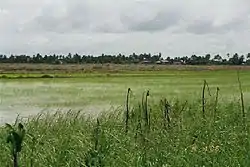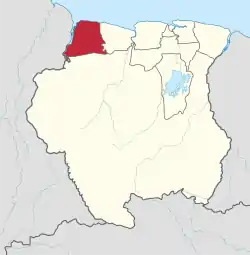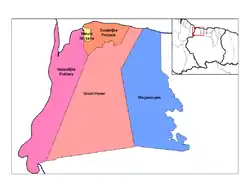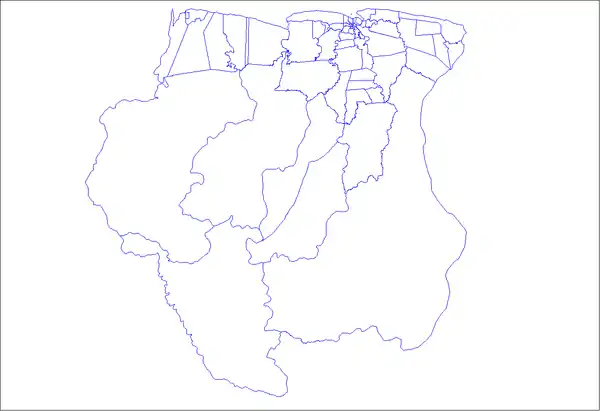Nickerie District
Nickerie is a district of Suriname, on the north-west coast. Nickerie's capital city is Nieuw-Nickerie. Another town is Wageningen. The district borders the Atlantic Ocean to the north, the Surinamese district of Coronie to the east, the Surinamese district of Sipaliwini to the south and Guyana to the west.[2]
Nickerie | |
|---|---|
 Rice fields in Nickerie | |
 Map of Suriname showing Nickerie district | |
| Coordinates: 5°46′N 56°52′W | |
| Country | Suriname |
| Capital | Nieuw-Nickerie |
| Area | |
| • Total | 5,353 km2 (2,067 sq mi) |
| Population (2012 census)[1] | |
| • Total | 34,233 |
| • Density | 6.4/km2 (17/sq mi) |
| Time zone | UTC-3 |
Nickerie has a population of 36.639 (2004) and an area of 5,353 km2.[1] Nickerie's population includes East Indian, Javanese, Afro-Surinamese, Chinese, and Europeans.[1]
Nickerie is bordered with Guyana. There is no bridge between the countries, but there is a ferry that sails between Molson Creek in Guyana and South Drain.[3]
History
In 1718, Dietzel became the first known person to settle in the area. In 1797, governor Juriaan François Frederici approved the first plantation in Nickerie. A large number of Scottish and English settlers arrived in the area during the British Occupation,[4] and primarily grew cotton and coffee.[2] The capital Nieuw Nickerie was built in 1879 after the former center of the district, Nieuw Rotterdam, was destroyed by floods.[5]
The name Nickerie is probably based on Neekeari which was first reported by Teenstra in 1596 for an indigenous tribe living the area.[6] The name also appears in Robert Dudley's The Voyage of Robert Dudley to the West-Indies, 1594-1595.[7]
Nickerie had a poor connection to Paramaribo. It was not until 1960s when the East-West Link was constructed linking Nickerie with the rest of the country.[4]
Resorts

Agriculture
.jpg.webp)
During the 19th century, Nickerie became home to many plantation. The abolition of slavery, transformed the area in smaller scale farming. In the late 19 century, many plantations start to shift to balatá production whose latex was used for driving belts and isolation, but started to become obsolete in the early 20th century.[8] In 1955, a project of poldering started, resulting in an increase of cultivatable land.[9]
Bananas and rice are the main crops grown in Nickerie. Some rice had been grown previously, but during the 20th century, Nickerie became the centre of the rice in Suriname,[2] mainly due to the East Indian and Javanese indentured laborers.[10]
Tourism
Nieuw Nickerie is started to develop as a tourist area. There are quite a number of hotels in the city, and the nearby Bigi Pan Nature Reserve opened opportunities for ecotourism.[11] In 1972, the Hertenrits Nature Reserve was founded.[11] In the reserve there are five terpen (artificial mounts). They were located in the middle of the swamp, and remains from the pre-Columbian era had been discovered in the mounts. Hertenrits has been added to the Bigi Pan reserve.[12]
References
- "Resorts in Suriname Census 2012" (PDF). Retrieved 27 May 2020.
- "Distrikt Nickerie" (in Dutch). Retrieved 27 May 2020.
- "Suriname Ministry of Tourism". Ministry of Tourism (in Dutch). Retrieved 27 May 2020.
- "Over Nickerie". Nickerie.net (in Dutch). Retrieved 27 May 2020.
- "Monuments". Suriname.nu (in Dutch). Retrieved 27 May 2020.
- "Encyclopaedie van Nederlandsch West-Indië - Page 509 - Nickerie" (PDF). Digital Library for Dutch Literature (in Dutch). 1916. Retrieved 27 May 2020.
- "The voyage of Robert Dudley, afterwards styled Earl of Warwick and Leicester and Duke of Northumberland, to the West Indies, 1594-1595". Internet Archive. Retrieved 27 May 2020.
- "Balata: een tijdelijke uitkomst". Nickerie.nl (in Dutch). Retrieved 27 May 2020.
- "Het Tienjarenplan: een sprong voorwaarts". Nickerie.nl (in Dutch). Retrieved 27 May 2020.
- "De opkomst van de rijstcultuur en de polders". Nickerie.nl (in Dutch). Retrieved 27 May 2020.
- "STRUCTUUR ANALYSE DISTRICTEN 2009-2013" (PDF). Planning Office Suriname (in Dutch). Retrieved 27 May 2020.
- "Waar het Bigi Pan Bijzonder Beheersgebied ligt" (in Dutch). Retrieved 27 May 2020.
